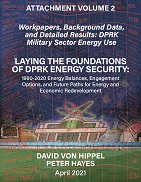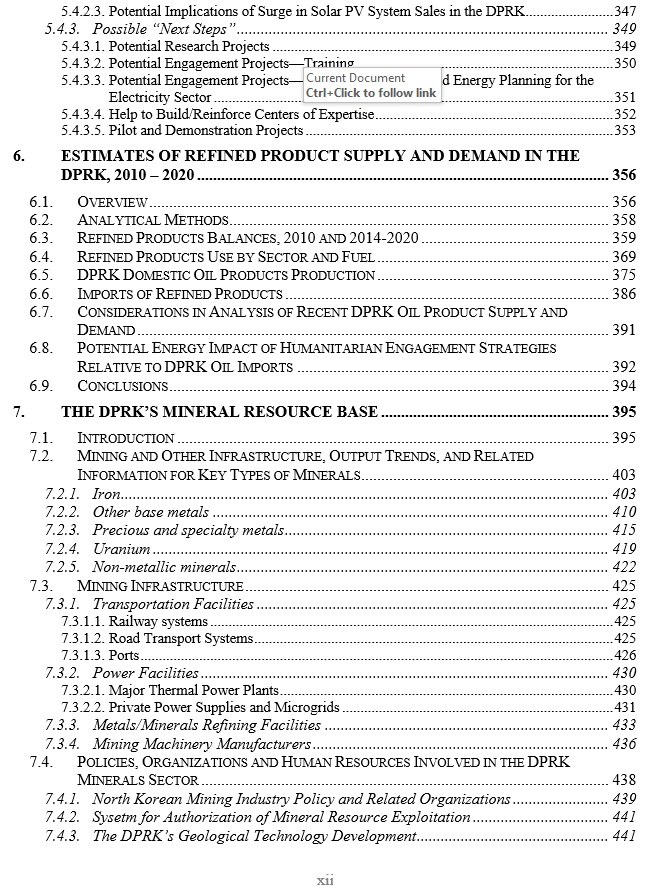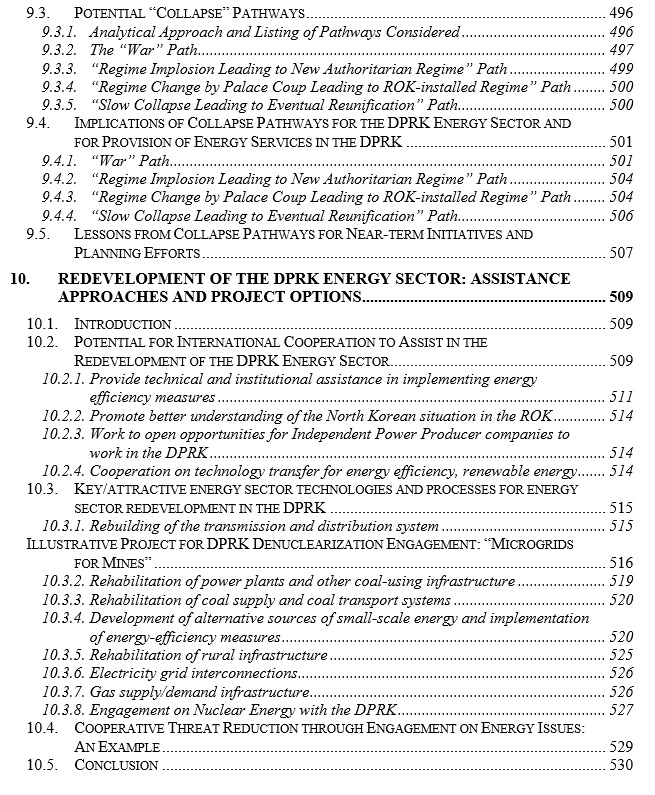DAVID VON HIPPEL AND PETER HAYES
APRIL 26 2021
I. INTRODUCTION
This report “provide[s] policymakers and other interested parties with an overview of the evolution of demand for and supply of energy in the Democratic Peoples’ Republic of Korea (DPRK) over the last three decades,” updated to 2020. The report provides a variety of possible future pathways for the DPRK energy sector, and outlines efficient and realistic policy measures for energy cooperative engagement with the DPRK in the context of implementing a strategy to denuclearize the Korean peninsula.
David von Hippel is Nautilus Institute Senior Associate. Peter Hayes is Director of the Nautilus Institute and Honorary Professor at the Centre for International Security Studies at the University of Sydney.
Full report here [18.5 MB PDF].
 Attachment 1 here [24.6 MB PDF]
Attachment 1 here [24.6 MB PDF]
 Attachment 2 here [2.3MB PDF].
Attachment 2 here [2.3MB PDF].
This report is published under a 4.0 International Creative Commons License the terms of which are found here.
The views expressed in this report do not necessarily reflect the official policy or position of the Nautilus Institute. Readers should note that Nautilus seeks a diversity of views and opinions on significant topics in order to identify common ground.
Banner image: “Arirang” festival in Pyongyang, September 2009 highlighting a nuclear reactor nuclear reactor and satellite dish is composed of cards held up by thousands of DPRK performers. Photo David von Hippel
II. NAPSNET SPECIAL REPORT BY DAVID VON HIPPEL AND PETER HAYES
LAYING THE FOUNDATIONS OF DPRK ENERGY SECURITY: 1990-2020 ENERGY BALANCES, ENGAGEMENT OPTIONS, AND FUTURE PATHS FOR ENERGY AND ECONOMIC REDEVELOPMENT
APRIL 26 2021
Executive Summary
The purpose of this report is to provide policymakers and other interested parties with an overview of the evolution of demand for and supply of energy in the Democratic Peoples’ Republic of Korea (DPRK) over the last three decades. This report provides estimates of demand and supply for 14 individual years during that span, namely:
- 1990, just before much of the DPRK’s economic and technical support from the Soviet Union was withdrawn;
- 1996, possibly when the DPRK hit its lowest economic point in the 1990s;
- 2000, a year that has been perceived by some observers as a period of modest economic “recovery” in the DPRK, and just before (October 2002) the nuclear confrontation re-erupted between the DPRK, the United States, and it neighbors in Northeast Asia over the DPRK’s nuclear weapons development program;
- 2005, when observers noted an upward trend in some aspects of the DPRK economy, as well as the most recent year for which any published estimates on the DPRK’s energy sector and economy are available;
- 2008 through 2010, starting with the last year in which the DPRK received heavy fuel oil from its negotiating partners in the Six-Party talks; and
- 2014-2019, recent historical years during which the DPRK economy began to grow with expanded coal exports to China, imports of consumer goods, and adoption of some additional aspects of a market economy, followed by several years during which the DPRK has been under United Nations Security Council sanctions affecting its energy trading (oil imports and coal exports) in particular, and marked by on-again, off-again interludes of engagement and conflict with the international community.
- 2020, the year of the coronavirus-19 pandemic, which has affected the economy and energy sector of every country on the map, including the DPRK.
Building on previous energy balances prepared for 1990, 1996, 2000, and 2005, 2008 through 2010, and 2014, the authors assembled information from as many data sources as possible to update our earlier work and to provide estimates of recent-year energy supply and demand in the DPRK. Somewhat revised results of the 1990, and 1996 energy balances, which provide the underpinnings of our updated DPRK energy sector analysis, as well as a detailed description of input parameters and assumptions used in the analytical process, are presented in Chapter 2 of the Report that follows.
The estimates of year 2000 and on energy demand and supply presented here are typically somewhat lower than some estimates assembled by others, including international statistical resources and ROK estimates. The estimates described in Chapter 3 of this report include overall year 2000 through 2020 gross electricity generation varying somewhat by year within the range of 13 to 18 terawatt-hours (TWh, or billion kilowatt-hours) annually, reflecting somewhat improved electricity sector performance in some recent years. Overall coal production between 2000 and 2020 peaked in 2016 at about over 1 million terajoules (TJ), or about 35 million tonnes of coal equivalent, of which more than half was exported, almost all to China. Crude oil imports in 2020 were an estimated 750,000 tonnes, somewhat higher than in previous years, and net refined products imports were 6.6 million GJ, or about 150,000 tonnes, a considerable decline from previous years caused, we estimate, but the combination of United Nations Security Council sanctions and the impacts of COVID-19. The electricity and coal output, and oil imports, estimates for even 2019 are on the order of one third of the levels of output and imports of these fuels as of 1990, and outputs in 2020 were lower due to COVID-19 restrictions on cross-border travel and activity within the DPRK imposed by the DPRK government to try to halt (or limit) the spread of the pandemic. The use of wood and biomass has to some extent, particularly in households in rural areas, made up for the lack of commercial fuels, and in-country observers and forestry experts alike note the negative impact of increased wood harvesting for energy on the DPRK’s forest resources and, in some areas, on soil fertility.
One major refinery continues to run in the DPRK as of 2020, and likely operated at a higher rate than in 2000 or through most of the 2010s, but at a lower level even than in 1996. A minor refinery also apparently operated periodically in 2000, and we assume that has continued to do so through 2020, though we have no direct recent evidence regarding this facility. Much of the electricity generation infrastructure in the DPRK continues to be in poor condition, though some rehabilitation of power plants has apparently taken place, thus our estimate is that thermal and hydroelectric power plant operable capacity (and output) are slightly higher than in 2000. Hydroelectric plants continue to be in somewhat better condition than thermal power plants, but remain at the mercy of water availability, and thus operate with relatively low capacity factors. Coal mines continue to be plagued with equipment and transport problems and, most importantly, by lack of electricity to operate mining machinery, lights, air supply, water pumps, and other crucial infrastructure, though selected coal mines have been upgraded in the 2010s to produce coal for export to China. The coal seams currently mined in many locations are becoming lower-yielding, or yield coal of lower quality, as the better deposits are mined and new seams are not opened up. In addition, many coal galleries are reportedly flooded—and may in some cases take years to pump out.
Industrial output is estimated to have declined, even by 2019 (with further declines in 2020), to 9 to 60 percent of 1990 levels, varying substantially by subsector—with export-oriented subsectors such as mining and metals showing the greatest activity relative to 1990 levels. As a consequence of this decline, the share of overall energy demand contributed by the industrial sector is now second to that of the residential sector, as shown in figure ES-1, though residential demand continues to include a substantial amount of wood and other biomass estimated to be used as “substitute” fuels in the absence of sufficient or consistent supplies of coal and electricity.
Figure ES-1

In Chapters 4 and 7 of this report, we review what is known about the DPRK’s natural resource base, with Chapter 4 focusing on fossil fuels and renewable resources including forests, and Chapter 7 providing more detail on other minerals, including existing mining infrastucture and institutions in the DPRK, along with a summary of some of the key challenges facing the minerals sector. The resources described in these Chapters, plus the productive capacity of the North Korean people, provides the base on which future economic and energy development in the DPRK will be built, and must be considered in any plan for DPRK energy sector assistance. Chapter 4 also provides updated results of our illustrative analysis of the “energy efficiency” resource in the DPRK, in which we estimate the potential cost and resource savings from the application of several key energy efficiency options for the DPRK energy demand and supply sectors. Chapters 5 and 6 of this report present, respectively, additional detail on the electricity and refined products supply sectors, including a review of resources available for use in generating power, and existing infrastructure, and oil refining infrastructure and oil product supply and demand.
Chapter 8 presents sketches and analysis of several future pathways for the DPRK economy and energy sector, including a “Redevelopment” pathway, and describes some of the preconditions for and impacts on the energy sector of different paths—including the relative costs and benefits of different DPRK energy futures, as well as their relative impacts on the DPRK’s energy security. Also described in Chapter 8 is a list of institutional changes—ranging from training to establishment of energy pricing practices to strengthening of regulatory agencies to setting out clear and consistent rules for commerce with foreign companies—that the DPRK should adopt and be assisted with in order to work toward rebuilding its energy sector.
Following on from the quantitative exploration of different DPRK energy futures in Chapter 8, in Chapter 9 we address the implications of a possible collapse of the DPRK’s government Although we continue to emphasize that in our view, even as the DPRK transitions to a new young leader, such a collapse is not likely, considering the possible implications of such a collapse provides insights into which policies by the international community are likely to be helpful in any kind of DPRK transition, whether abrupt or gradual and managed.
Chapter 10 provides suggestions on a number of areas for international cooperation, including providing technical and institutional assistance in implementing energy efficiency measures, promoting better understanding of the North Korean situation in the ROK, working to open opportunities for independent power companies to work in the DPRK, and cooperation on technology transfer for energy efficiency and renewable energy. Key and attractive energy sector technologies and processes for energy sector redevelopment in the DPRK are identified, including rebuilding of the electricity transmission and distribution system, rehabilitation of power plants and other coal-using infrastructure, rehabilitation of coal supply and coal transport systems, development of alternative sources of small-scale energy and implementation of energy-efficiency measures, rehabilitation of rural infrastructure, advanced investigation of regional electricity grid interconnections, and gas supply and demand infrastructure development. Referring to another recent report by the authors, Chapter 10 also includes a brief description of a potential cooperative threat reduction “plus” approach led by a non-governmental consortium of international actors and focused on building energy efficiency, renewable energy, and microgrid measures, all of which DPRK representatives have consistently shown a keen interest in. Also discussed, in response to the DPRK’s announcement of its construction and operation of a uranium enrichment facility and ongoing construction of a small experimental light water nuclear reactor, are possibilities for international cooperation with the DPRK on peaceful activities in the nuclear energy arena.
This document is intended to provide a best estimate, given available data, of an internally consistent energy supply/demand balance for the DPRK for the most recent year that our analysis covers, 2020, as well as balances for previous years prepared with similar methodologies. In so doing, we have tried to assemble what is known, and assess what is not known, about the DPRK energy sector. As with previous reports, this analysis is intended to be revised as more and better data are available, and the authors welcome reader comments and input on the material presented here. For example, much of the analysis for energy supply and demand in the DPRK for the year 2020 presented here was prepared before 2020 was over, and given recent news reports (still almost all anecdotal) of energy shortages in the DPRK during 2020, we would say that our estimates of energy use, and particularly electricity use, might in fact be a bit higher than actual values in 2020, to the extent that they could or can be known.
As this report is being finalized, a new administration in Washington D.C is just entering its second month in office. How the administration of President Biden will approach the possibility of discussions with Chairman Kim Jong Un’s regime on the DPRK’s nuclear weapons program and other issues is not yet fully evident, although President Biden seems likely to take a much more collaborative approach, at least with regard to coordination with the Republic of Korea and Japan than did his predecessor. Ultimately, however, the DPRK, the United States, and the DPRK’s neighbors, and other parties will need to return to the bargaining table, and at that point, as in past negotiations, provision of energy security will continue to be a critical element of a successful and robust resolution to the nuclear confrontation between the DPRK and the international community.
Foreword
As this Report is released, prospects for engagement of the international community with the DPRK on its nuclear weapons program and a variety of related issues seem indeterminate. This state of affairs has not been unusual over the past 30 years, with opportunities for diplomacy waxing and waning as leadership of the countries involved changed, as the DPRK’s rhetoric toward the ROK and the US, in particular, has oscillated from strident to conciliatory and back (often with matching rhetoric on the other side), as conditions inside the DPRK have changed, and as politicians in all of the countries involved have adjusted their approaches to engagement to, in part, address domestic political needs. Still, a new administration in Washington, an ROK administration with a generally favorable attitude to engagement, and signals from the DPRK that, while decidedly mixed, appear to offer hope for at least sitting down for discussions, suggest that there may be an opportunity for progress in addressing concerns related to the DPRK. Given the deep reservoir of distrust that has built up between the DPRK and those who would seek to engage it in discussions, any such engagement must be considered a long-term effort, one in which any given day, month, or even year may see steps back, but in which steady progress must be the goal.
Since the early 1990s, we have contended that one of the core (though not only) reasons that the DPRK has pursued development of nuclear weapons and related delivery systems has been energy insecurity—namely the lack of adequate fuel supplies and energy conversion systems—particularly electricity generation systems—to support a reasonable rate of economic development. Starting with the publication, in 1995, of our first report related to analysis of the DPRK energy sector, and its prospects for evolution in the future, we have worked to provide those who study the DPRK, and particularly those whose jobs are to figure out ways to engage the DPRK, with analysis of what is known, what can be inferred or estimated, and what isn’t known about the DPRK energy sector, because we see an understanding of the DPRK’s energy systems and energy needs as crucial for the international community to be able to develop meaningful energy sector engagement with the DPRK. And, as shown in many of the agreements forged (if later abandoned) with the DPRK over the years, energy sector measures are crucial to providing the DPRK with incentives to engage.

Photo of performance at “Arirang” festival in Pyongyang, September 2009. The background image of a nuclear reactor and other technologies is composed of cards held up by thousands of DPRK performers seated in the steeply-pitched area on the other side of the stadium from where the photo was taken. Photo by D. von Hippel.
The cover of this report is a composite of two different images. The grid of red text and lines represents an estimated “energy balance”—a common tabular representation of the supply and demand of the different forms of energy used in an economy—for the DPRK, in this case, for the year 1996. Energy balances like this one summarize where an economy has been, with regard to energy supply and demand, where it is currently, and where it might be going (balances for future years). The underlying image, showing a nuclear power plant and other infrastructure of the modern age, shows the DPRK’s vision of where it saw its energy sector and broader economy going, at least as of 2009. This image (provided above) was presented by a cast of many thousands of North Koreans in a large stadium in Pyongyang at the fall “Arirang” festival in late September, witnessed in person by one of us (von Hippel). It represents a message relaying the country’s leadership’s aspirations to the international audience in attendance and, just as crucially, to the DPRK people. As such, it represents a marker for what the DPRK may most value out of any engagement with the international community, and should be taken into account by those in the US, ROK, and elsewhere who are working to prepare diplomatic initiatives to engage the DPRK.







III. NAUTILUS INVITES YOUR RESPONSE
The Nautilus Asia Peace and Security Network invites your responses to this report. Please send responses to: nautilus@nautilus.org. Responses will be considered for redistribution to the network only if they include the author’s name, affiliation, and explicit consent



